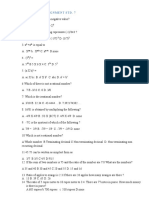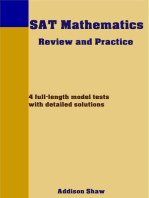Grade 8
Uploaded by
kavithapr1989Grade 8
Uploaded by
kavithapr1989MGM SCHOOL KANIYAPURAM
FIRST MID-TERM EXAMINATION 2024-25
MATHEMATICS
Name …………………. Max. Marks: 25
Grade VIII Time: 1Hr
SECTION A
I Choose the correct answer from the following (8 × 1=8)
1. Which of the following is the Multiplicative identity for rational numbers?
a) 1 b) -1 c) 0 d) None of these
2𝑥
2. If = 4, the value of x is-
5
8 8
a) 10 b) -10 c) – d)
5 5
1 3
3. The value of x is equal to:
2 5
1 3 3 2
a) b) c) d)
2 10 5 5
4. Which of the below listed is not a Quadrilateral?
a) Parallelogram b) Square c) Triangle d) Rectangle
5.________ is not associative for rational numbers.
a) Subtraction or Division b) Addition or Multiplication
c) Addition or Division d) Multiplication or Division
1 1
6. The value of + is equal to:
2 4
3 3 2
a) b) c) d) 1
4 2 3
7. Which of the following is the sum of its exterior angles?
a) 540° b) 180 c) 720° d) 360°
𝑥 7
8. If +1= , then which of the following is correct?
3 15
𝑥 7 𝑥 7 𝑥 7
a) = –1 b) =- + 1 c) =- –1 d) none of these
3 15 3 15 3 15
SECTION B
II Do as directed (6 × 2 =12)
9. Simplify and solve the linear equation 3(t−3) = 5(2t+1)
10. Find x in the following figure.
11. Name the property under multiplication used in each of the following:
a) (−45) × 1 = 1 × (−45) = (−45)
b) (−1317) × (−27)= (−27) × (−1317)
12. Using suitable rearrangement and find the sum.
4/7 + (-4/9) + (3/7) + (-13/9)
13. How many sides does a regular polygon have if the measure of an exterior angle
is 24°?
𝑥 1 𝑥 1
14. Solve − = +
2 5 3 4
SECTION C
III Solve the following (2 × 2½ = 5)
15. Find using appropriate property :
2 −(3) 1 3 3
𝑋( )− − 𝑋
5 7 14 7 5
1 −2 1
16. If x = , y = and z = , verify that x × (y × z) = (x × y) × z.
2 3 4
You might also like
- Module-3 Association Analysis: Data Mining Association Analysis: Basic Concepts and AlgorithmsNo ratings yetModule-3 Association Analysis: Data Mining Association Analysis: Basic Concepts and Algorithms34 pages
- Sample Test Questions - Sy 2019-2020 MathematicsNo ratings yetSample Test Questions - Sy 2019-2020 Mathematics11 pages
- Class8 Maths - WS1-Chapter 1 Rational Numbers Mumbai2No ratings yetClass8 Maths - WS1-Chapter 1 Rational Numbers Mumbai24 pages
- + BX + C 0, A 0 + BX + C 0, A 0: Directions: Read and Analyze Each ItemNo ratings yet+ BX + C 0, A 0 + BX + C 0, A 0: Directions: Read and Analyze Each Item3 pages
- Which of The Following Is A Set of Rational Numbers?No ratings yetWhich of The Following Is A Set of Rational Numbers?4 pages
- Good Luck!!!: 1 Periodic Test Mathematics 8No ratings yetGood Luck!!!: 1 Periodic Test Mathematics 85 pages
- Second Periodical Test in Mathematics 9 S.Y. 2018-2019No ratings yetSecond Periodical Test in Mathematics 9 S.Y. 2018-20195 pages
- AKU EB - General Mathematics - X - Paper I - 2012 - MayNo ratings yetAKU EB - General Mathematics - X - Paper I - 2012 - May8 pages
- Mathematics 7 First Quarter Exam 2019-2020No ratings yetMathematics 7 First Quarter Exam 2019-202015 pages
- Orca Share Media1674112820348 7021738098839885419No ratings yetOrca Share Media1674112820348 70217380988398854193 pages
- Practice Test A: 60 Minutes - 60 QuestionsNo ratings yetPractice Test A: 60 Minutes - 60 Questions50 pages
- ACET2013 SIMULATED-EXAM-SET-A SECTION-2 MATHEMATICS-PROFICIENCY Final v05202013No ratings yetACET2013 SIMULATED-EXAM-SET-A SECTION-2 MATHEMATICS-PROFICIENCY Final v052020137 pages
- Std Viii Mathematics Term1 2024 25 Set ANo ratings yetStd Viii Mathematics Term1 2024 25 Set A5 pages
- IX Math Final Exam Revision worksheet (MCQs)No ratings yetIX Math Final Exam Revision worksheet (MCQs)2 pages
- Class 7 - Sample Paper 01 - Final Examination - Mathematics - 2023 - 24No ratings yetClass 7 - Sample Paper 01 - Final Examination - Mathematics - 2023 - 246 pages
- A New Radar Waveform Design Algorithm With Improved Feasibility For Spectral CoexistenceNo ratings yetA New Radar Waveform Design Algorithm With Improved Feasibility For Spectral Coexistence10 pages
- BADENAS y AURELL, 2004 - Sea Level Changes, JabaloyasNo ratings yetBADENAS y AURELL, 2004 - Sea Level Changes, Jabaloyas17 pages
- Lectures 1 - 10 Introduction To Classical Mechanics: Prof. N. Harnew University of Oxford MT 2016No ratings yetLectures 1 - 10 Introduction To Classical Mechanics: Prof. N. Harnew University of Oxford MT 2016102 pages
- Federal Investigation Agency (FIA) : Recruitment TestNo ratings yetFederal Investigation Agency (FIA) : Recruitment Test4 pages
- Chapter 4 Mechanical Properties of MetalsNo ratings yetChapter 4 Mechanical Properties of Metals19 pages
- 24by09in00002376 - Sky Ventureszdup - 27-07-2024No ratings yet24by09in00002376 - Sky Ventureszdup - 27-07-20242 pages
- Anton Paar Density Meter DMA 1001 Operation ManualNo ratings yetAnton Paar Density Meter DMA 1001 Operation Manual26 pages
- Amendment No 1 2002 To BS 7671 and Ring Circuits: BackgroundNo ratings yetAmendment No 1 2002 To BS 7671 and Ring Circuits: Background4 pages
- Encyclopedia of Embroidery From The ArabNo ratings yetEncyclopedia of Embroidery From The Arab3 pages

























































































